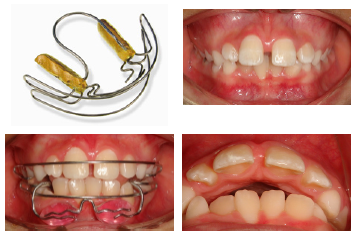Early treatment of Class II malocclusions with the Klammt’s Elastic Open Activator (KEOA). Case report
Keywords:
Early childhood, caries, ICDAS, early treatment, maloclussion, class II maloclussion, activatorMain Article Content
Summary: Treatment of malocclusions at early
ages is more frequent in modern dentistry. The maxillar functional orthopaedics provides different
therapeutic that facilitate the correction of malocclusion allowing patients to reach during child
development. The functional orthopaedic devices allow the correction of different maxillary
alterations in a fast and efficient way. This is accompanied by integral and functional attention of
the patient, to obtain the correction of the maloclussion. The Elastic Open Activator of Klammt
(AAEK) was designed by George Klammt in Germany more than 50 years ago, and it is a good election
for the early correction of the class II malocclusions supporting the treatment in right diagnosis.
Key words: Early childhood caries. Dmf. ICDAS.
status in the United States:prevalence of
malocclusion. J Dent Educ 1985; 49:386-
96.
2. Álva r e z CA. Fr e cuenc i a de los
Componentes de la maloclusión clase
II esquelética en dentición mixta.
Medigraphic 2006; 63(6):210-214.
3. McNamara JA, Bookstein FL, Shaughnessy
TG. Skeletal anddental changes following
functional regulator therapy on Class II
patients. Am J Orthod 1985; 88:91-110.
4. Baccetti T, Franchi L. Maximizing
esthetic and functional changes in Class
II treatment by means of appropriate
treatment timing. In: McNamara JA, Kelly
K, eds. New Frontiers in Facial Esthetics.
Ann Arbor, Mich: Center for Human
Growth and Development, The University
of Michigan; 2001.
5. Faltin K, Rolf M, Faltin TB, Franchi L,
Ghiozzi B, McNamara JA. Long-term
Effectiveness and Treatment Timing for
Bionator Therapy Angle Orthod 2003;
73:221-230.
6. McNamara JA, Brudon WL. Orthodontics
and Dentofacial Orthopedics. Ann Arbor
Mich: Needham Press; 2001. 67-80.
7. Woodside, Metaxas, Altuna. The influence
of functional appliance therapy on glenoid
fossa remodeling.Am J Orthod Dentofacial
Orthop 1987; 92:181-98.
8. Rabie ABM Does the degree of
advancement during functional appliance
therapy matter? European Journal of
Orthodontics 2008; 30:274-282.
9. Rabie ABM. Replicating mesenchymal
Figura 9. Control 18 meses.
Figura 10. radiografias de control (lateral de cráneo y panorámica).
Figura 11. fotografías faciales de control (frente reposo, frente sonrisa y perfil reposo).
Tabla 3. Comparación de medidas cefalométricas.
Medidas Inicial final
SNA 86° 83°
SNB 78° 80°
ANB 8° 3°
Co-A 82mm 83mm
Co-Pg 105mm 109mm
Co-B 94mm 98mm
Is-PP 123° 112°
IMPA 92° 92°
Resalte 11mm 4mm
29 Revista Estomatología
cells in the condyle and the glenoid fossa
during mandibular forward positioning.
Am J Orthod Dentofacial Orthop 2003;
123:49-57.
10. Shum L. Vascular endothelial growth
factor expression and bone formation in
posterior glenoid fossa during stepwise
mandibular advancement. Am J Orthod
Dentofacial Orthop 2004; 125:185-90.
11. Petrovic A, Stutzmann J,Lavergne J:
mechanism of craniofacial growth and
modus operandi of functional apliances:
A cell level and cybernetic approach
to orthodontic decisión making.in
craniofacial groeth seris 23, Ann Arbor:
University of Michigan; 1990.
12. Aguila JF. Tratado de ortodoncia,
teoría y práctica. Actualidades Medico
Odontológicas. Primera edición;
Latinoamérica: 2000. Tomos I y II 379-
425.
13. Graber TM, Neumann B. Aparatologia
ortodoncica removible. Panamericana;
1987. 327-43.
14. Bishara S. Ortodoncia. Mc Graw Hill:
México DF; 2003.
15. Canut JA. Ortodoncia Clínica y
Terapéutica. Masson: Madrid; 2001.
16. Proffit WR, Fields HW. Ortodoncia: teoría
y práctica. Segunda edición. Times Mirror
International: Madrid;1995.
17. Simoes W. Ortopedia funcional de los
maxilares A través de la Rehabilitación
Ne u r o -Oc l u s a l .Ar t e s me d i c a s
Latinoamericanas 2004; 1(3):67-74.
18. Perez LM, Saenz ML, Castillo R, Soto.L,
Grau R. Adaptación funcional con el uso
del activador de Klammt relacionada con
el grado de protrusión mandibular. Rev
Cubana Ortod 2001; 16(2):96-101.
19. Vo u d o u r i s JC. Co n d y l e - F o s s a
modifications and muscle interactions
during Herbst treatment, Part 1. New
technological methods AJO-DO 2003;
123:604-13.
20. Rabie ABM. Does the degree of
advancement during functional appliance
therapy matter? European Journal of
Orthodontics 2008; 30:274-282.
21. Kurt F, Rolf M. Faltin TB, Franchi L,
Ghiozzi B, McNamara JA. Long-term
Effectiveness and Treatment Timing for
BionatorTherapy. Angle Orthod 2003;
73:221-230.
22. Tulloch JF, Phillips C, Proffit WR. Benefit
of early Class II treatment: Progress report
of a two-phase randomized clinical trial.
Am J Orthod Dentofacial Orthop 1998;
113: 62-72.
Downloads
Los autores/as conservan los derechos de autor y ceden a la revista el derecho de la primera publicación, con el trabajo registrado con la licencia de atribución de Creative Commons, que permite a terceros utilizar lo publicado siempre que mencionen la autoría del trabajo y a la primera publicación en esta revista.

